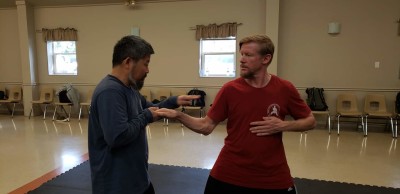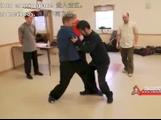Recently at a 2019 Toronto CA workshop hosted by Kevin Ho, Master Chen Zhonghua demonstrated and taught the participants a training drill that requires the starting position to have the rear heel off the floor and both hands in a double push position, chest high. While going over this drill and teaching to the finer more precise details, he offered that we students feel his back leg starting positions with our hands. One hand was to be placed on the ankle while the other on the inside thigh to feel the active tendons and muscles. He suggested that students pull or rake across these two areas to gain a better understanding of the physical requirements for the drill. When I took my turn, pulling across these areas, something registered with me to the feeling of the amount of tension in the leg as well as what precisely for this move was being used to generate such great power, and speed.
The concept offered by MC is one I have heard him talk about in the past called the “guitar string” analogy. This speak of comparing the guitar string to a line of muscle and tendons never truly hit home with me until I had this hands on experience. I will try to explain this the best I can in my own words in hopes that it helps someone else on their taiji journey. I do not have have a PhD in music, so you may find my description invalid if you are an educated person. I can only fumble here with my experiences as a stringed instrument technician. Feel free to correct me if I have errors here, as I always enjoy learning more.
Let us start with the actual example, the instrument string…
When a ‘string’ made from materials such as wire or nylon is strung or pulled across an instrument such as a guitar, lute, violin, upright bass or other, it is stretched to a specific tension that is desired for a specific intended result. For the case of the musician we call the result of this tension the ‘pitch’ once it is been placed into motion. This string when pulled, stretched, or struck, immediately starts to ‘cure’ or settle back to its resting point. The amount of time duration it takes for this to occur is called ‘sustain’. The point of the string where it is struck, travels to the exact opposite side passing through its original settled position at a sustained rate for just under or slightly less than the length of the original pull. This continues to occur at a lesser and lesser rate as the tension starts to equalize and return to a motionless state. Keep in mind a string not in motion cannot move air, thereby no sound wave or frequencies are produced without the musician placing the string in a vibrating state. No movement, no sound, however the resting strings state of tension, still exists.
If we take a solid core nickel/steel string with a scale length of 25 1/2” at a .016 gauge and bring it to a playable frequency of say G4 (196hz) it requires 14.7lbs of stretch to produce this pitch. If we examine a larger string with a wire wrapping around (making the string denser in mass) at the same scale length, .042 gauge for a set frequency of E6 (1319hz) it requires 14.8lbs to bring it to pitch. As you can see, the tension is almost equal in both examples though the physical size on one string has more weight. Both strings will feel to the hand to have roughly the same tension though the resulting frequency and settling rate is vastly different. So we could say on the body, the denser string is the leg, the thinner string is the arm.
The deserning musician will decide as to the where, how, how much and at what speed and angle the ‘attack’ is issued to the resting string to generate a motion. This action does effect the outcome of the previously talked about curing process result. For instance if a string is say 3 feet long, and is pulled in the exact center, the center release will actually cause an equal wave of energy to resonant out to both ends to the farthest not moving point, then these two waves will reverse their energy and come back to the center only to repeat over and over, smaller and smaller until once again still. Should the string be pulled or struck at say the 1 foot mark from either end, the result is different from the previously described action. The 2 foot side will wave or resonate a wave at a different length than the 1 foot side. This causes a difference in the resulting sound we call the ‘overtone’. (Maintain this concept and think of the knee joint as the 2 foot point and the ankle joint as the 1 foot point on the body, it will make sense later in the article).
What is neat about the human body is we can instantly bring a line into say, the rear supporting leg example that I am using here MC performed, and we can adjust that tension on the fly so to speak. So my experience in raking across the Gracilis/sartorius muscles and Achilles tendon of MC rear leg when tension was present, was just like the feeling of an upright bass string. I could actually feel his front hands through the controlled tension of these tendon and muscles. I realize that sounds odd, but unless you have had the honor of being able to touch MC when he is generously offering for one to do so in his teachings, this description may appear just that. Additionally, when I stood back up so the the next person could take their turn, I immediately became aware of this line in my own rear leg, as if I never knew it was there before but could feel it now.
The class spent well over an hour performing this foot/hand separation drill and it really awoke a new feeling in my body. I was able to sense how the weight of my rear leg is obviously heavier than that of my arms, but if I could truly make one controlled line of equal tension from the heel to the front hands, and not move the middle, I could create a lot more power when performing the drill. My many descriptions of the guitar string earlier mentioned, can be seen clearly, at least I think so, here in the actual video of this drill as performed by MC the day he taught this…
http://practicalmethod.com/2019/09/foot-hand-separation-exercise-2019/
Here is a segment of learning this for the upper body from the actual workshop as well hosted by disciple Kelvin Ho in Toronto…
http://practicalmethod.com/2019/09/to1909-frontbackextension-mp4-online-video-purchase/
One other point I should mention is that the quality of the guitar string also matters. So training in the PM system as we are instructed to do so will improve that quality vastly over time, producing a stronger faster action when this is performed on the body.
In closing I would say if you have not yet been able to get out to a seminar or workshop and actually feel some of these things in a learning environment on Master Chen’s body, I recommend you do so. Reading and videos are helpful, though the hands on approach MC so willingly allows and offers to the Taiji community is invaluable.
Chinese translation: https://www.shiyongquanfa.cn/archives/114875




{ 1 comment… read it below or add one }
This article is about a discussion at last year’s (2019) workshop in Toronto during which Master Chen Zhonghua demonstrated an important drill in Chen Style Taijiquan Practical Method. Master Chen uses this drill to demonstrate “Swallow and Spit.”
One of the key training aspect of Chen Style Taijiquan is that of eccentric stretching (central to our grinding, kneading, torquing). From my point of view, it is important because it is about stretching the connective tissues not only of tendons and ligaments but also of *fascial and myofascial connections*. To me, this aspect of training is an important element which can provide us with a power that has great explosive potential–the gongfu as demonstrated by Master Chen Zhonghua himself is probably the manifestation of his dedicated years of training and practice of this power from elastic energy. The timing, alignment, synergy of grinding (of the arms) and tapping (of the heel) in “Swallow and Spit” drill is an excellent example of the fine tuning and exploitation of this source of energy.
Fascia lines or anatomy trains: https://thetaichieffect.com/the-anatomy-of-connection/fascial-lines-in-our-body/